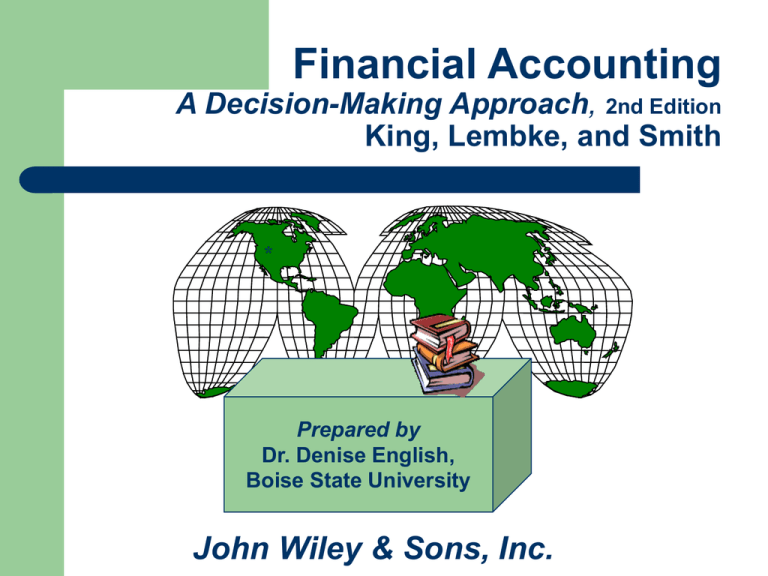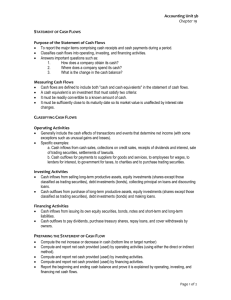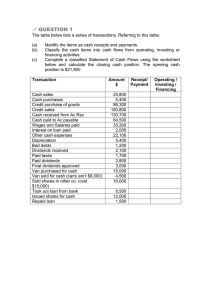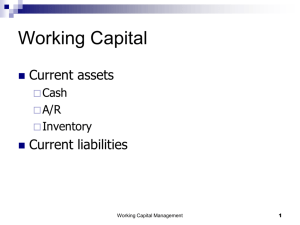
Financial Accounting
A Decision-Making Approach, 2nd Edition
King, Lembke, and Smith
*
Prepared by
Dr. Denise English,
Boise State University
John Wiley & Sons, Inc.
CHAPTER
THIRTEEN
THE CASH FLOW
STATEMENT AND
DECISIONS
After reading Chapter 13, you should be able to:
1. Describe the type of information included in a cash flow
statement, how it is organized, and how it is useful for
decision making.
2. Describe the different types of cash flows that are
important for decision makers and how these cash flows
are reported.
3. Explain the cash flow effects of common types of
transactions and describe how they are reported in the
cash flow statement.
4. Explain how decision makers analyze cash sources and
uses listed in the cash flow statement, and describe
ratios often used in analyzing cash flow.
Understanding the
Statement of Cash Flows
A Statement of Cash Flows is required by
generally accepted accounting principles to be
included in a complete set of financial
statements.
The purpose of the cash flow statement is to
report how an organization generated and
used its cash. Cash and cash equivalents are
usually combined and reported as cash.
Organization of the
Statement of Cash Flows
Purpose: provide information about the sources and
uses of cash due to operating, investing, and
financing activities for a defined period of time.
Presentation Formula:
Net cash provided (used) by operating activities
+ Net cash provided (used) by investing activities
+ Net cash provided (used) by financing activities
--------------------------------------------------------------Net increase(decrease) in Cash
====================================
Organization of the
Statement of Cash Flows
The Statement of Cash Flows is organized into three
categories: operating, investing, and financing.
1) Cash flows from operations are generated from normal
activities. They are routine and recurring and must be
positive over the long run for the company to remain viable.
2) Cash flows related to investing reflect how an
organization’s cash is used to provide future benefits, such
as through buying equipment and investments in securities.
3) Cash flows related to financing reflect amounts received
by borrowing or from issuing stock, as well as payments
made to retire debt, repurchase stock, and provide
dividends to owners.
Some of the Different
Types of Cash Flows
Exhibit 13-2
(partial)
Cash Flows Related to Operating Activities:
Cash receipts and collections from sales of goods and
services
Cash receipts from earnings on investments in securities
(interest and dividends)
Payments to suppliers
Payments to employees
Payments for interest
Payments for taxes
Some of the Different
Types of Cash Flows
Exhibit 13-2
(partial)
Cash Flows Related to Investing Activities:
Cash receipts from the sale of securities of other
companies
Cash receipts from sales of productive assets
Payments for the purchase of securities of other
companies
Payments at the time of purchase for the acquisition of
productive assets
Some of the Different
Types of Cash Flows
Exhibit 13-2
(partial)
Cash Flows Related to Financing Activities:
Proceeds from issuing capital stock or other equity securities
Proceeds from issuing debt securities or obtaining loans
(other than trade credit)
Payments for reacquisition of capital stock or other equity
securities of the entity
Payments for the retirement of debt securities (excluding
interest)
Payments of principal on loans (other than trade payables)
Payments of dividends
Tying Together Activities
and Financial Statements
The Statement of Cash Flows ties together
the balance sheet, income statement, and
statement of changes in stockholders’ equity by
reporting the effects of an entity’s operating,
investing, and financing activities on the cash
balance.
More specifically, the cash flow statement
reflects the changes in the balances of all
balance sheet accounts.
Operating Cash Flows
The operating section of the cash flow
statement is most important because it deals
with cash generated or used by primary
activities.
Most companies present this information using
an indirect approach, starting with accrualbasis net income and adjusting that figure to
obtain cash generated or used by operations.
Adjustments to Net Income
To determine cash generated by operations, several
adjustments to accrual-basis net income are necessary:
1) Add back expenses that reduced net income this period but did
not use cash.
2) Deduct cash payments made this period for expenses of other
periods.
3) Deduct revenues that did not result in cash inflows during the
current period.
4) Add cash collections for revenues earned in other periods.
5) Remove items reported in the income statement that are not
directly related to normal operations.
Depreciation
and Amortization
Under accrual accounting, depreciation reduces income;
however, depreciation expense, is not a cash expense.
Depreciation is neither a source nor use of cash, but must
be added back to convert net income to determine cash
generated by operations.
The amortization of intangibles and the depletion of
natural resources also result in noncash expenses that
must be added to net income on the cash flow statement
to determine cash generated by operations.
Changes in
Deferred Income Taxes
If temporary differences exist between the income
reported in the income statement and that reported on
the tax return, a deferred tax liability or asset is
affected.
The tax expense reported in the income statement is
different from cash tax payments.
The cash flow statement must report an adjustment for
deferred income taxes to bring net income to the
amount of cash generated from operations.
Amortization of Debt
Discount or Premium
Debt discount arises when debt is issued for less than
its maturity value; this results in actual actual interest
costs higher than the current cash interest payments.
Thus, the amortization amount must be added to net
income to determine cash generated by operations.
Debt premium arises when debt is issued for more
than its maturity value, resulting in actual interest costs
lower than current cash interest payments. Thus the
amortization amount must be subtracted from net
income to determine cash generated by operations.
Gains and Losses
Gains and losses included in the income statement not
directly related to regular operations (such as on the
disposal of investments or fixed assets, or from debt
retirements), must be eliminated from the amount of
cash flow generated by operations.
Gains must be deducted from net income while losses
must be added to net income to determine cash
generated by operations.
Changes in Current
Assets and Liabilities
Current assets and current liabilities play an
important role in the operating cycle of a business;
thus, changes in these must be considered in
determining the cash generated from operations.
For example, sales generate cash unless they are
on credit and the receivable has not yet been
collected; in the same way, costs of operations use
cash unless they are on credit and have not been
paid by period end.
Adjustments Related to Changes
in Current Assets and Current Liabilities to
Compute Cash Flows Generated from Operations
Exhibit 13-3
Current Assets
Current Liabilities
Accounts Receivable:
Increases--subtract from net
income
Decreases--add to net income
Inventory:
Increases--subtract from net
income
Decreases--add to net income
Other Current Assets
(e.g. Prepaid Expenses):
Increases--subtract from net income
Decreases--add to net income
Accounts and Trade
Notes Payable:
Increases--add to net income
Decreases--subtract from net
income
Other Liabilities (e.g. accruals),
excluding nontrade payables:
Increases--add to net income
Decreases--subtract from
net income
Assessing Cash Flows
from Operations
By examining the elements of the operating
section of the cash flow statement, decision
makers might be able to identify cash,
receivables, and inventory management
problems that could affect liquidity
A credit crisis could be identified by noting
increases in current payables, indicative of not
paying bills.
Investing Cash Flows
Organizations usually must invest cash so they can
conduct the operating activities needed to attain their
goals.
Analyzing the investing activities section of the cash
flow statement can indicate whether the company is
expanding or contracting its operating capacity.
Examining the cash expended for plant and equipment
in comparison with the amount of depreciation expense
and the related balance sheet assets can provide
insight on rate of growth or contraction.
Financing Cash Flows
The financing section of the cash flow statement
reports on the cash effects of the following:
1) borrowing (other than trade payables)
2) repaying debt (other than trade payables)
3) issuing stock
4) repurchasing stock, and
5) paying dividends.
Reporting Changes in
Financial Position
The statement of cash flows provides information
about cash inflows and outflows, as well as bridges the
gap between one balance sheet and the next.
The income statement provides part of the
explanation as to why financial position changed during
the year.
The statement of stockholders’ equity provides
another part of the explanation with respect to changes
in equity.
Supplemental Cash
Flow Information
Certain changes in financial position do not affect cash
directly, but are important investing or financing
activities of which financial statement readers must be
informed.
For example, the exchange of land for a long-term debt
agreement does not affect cash, but represents both
investing and financing activity, and must be disclosed.
Such disclosures are provided in a separate section of
the cash flow statement, or in notes to the cash flow
statement or financial statements in general.
The Direct Approach to the
Cash Flow Statement
The FASB recommends presenting the cash flow statement
using the direct approach, focusing on cash flows directly,
rather than starting with net income and adjusting for
noncash items.
Cash received from customers, cash interest or dividends
received from investments, and cash received from other
income sources, as well as cash payments made to suppliers
and employees, and cash paid for interest and for taxes
would be directly reported.
Noncash revenues and expenses and nonoperating gains
and losses are not included because they have no cash
effects.
Cash Flow Measures
Related to Return
A ratio that is useful in determining a company’s
ability to pay dividends, and over time, how
successful their operations are is Cash Flow
per Share, computed as follows:
Cash Flow
per Share
=
(Net cash provided by operations Dividends on preferred stock)
-------------------------------------------Common shares outstanding
Cash Flow Measures
Related to Return
Another cash measure of return is the ratio of Cash
Flow to Total Assets, which provides a measure of
cash return on the investment and can be used over
time as a measure of profitability. It is computed as
follows:
Cash Flow
to Total
Assets
Cash flow from operations
= -------------------------------------------Average total assets
Cash Flow Measures
Related to Return
One other measure of return that is discussed by
analysts is Free Cash Flow. This measure indicates
the amount of cash that is generated by operations,
after maintaining productive capacity. It is computed as
follows:
Free Cash Flow = Cash generated
from operations
Cash invested
-to maintain
capacity
Cash Flow Measures
Related to Safety
Cash flow measures related to safety have to do with
how cash flows from operations compare with some
required or anticipated payment. One such measure is
the ratio of Dividends to Operating Cash Flow,
calculated as follows:
Dividends to
Operating Cash =
Flow
Current dividends paid
---------------------------------Cash provided by operations
Cash Flow Measures
Related to Safety
Another measure of safety is the ratio of Cash Flow to
Current Maturities of Debt. This ratio indicates a
company’s ability to generate enough cash from its
operations to repay debt commitments that mature in
the near future, excluding normal trade payables. It is
calculated as:
Cash Flow to
Maturing Debt
=
Cash provided by operations
---------------------------------------Debt maturing currently
Cash Flow Measures
Related to Safety
A similar measure of safety is the ratio of Cash Flow to
Total Debt. This ratio takes a longer-run view by
comparing current cash flow from operations with total
liabilities. The higher the ratio, the better a company’s
debt-paying ability and the better the safety margin for
creditors. It is calculated as follows:
Cash Flow to
Total Debt
=
Cash provided by operations
---------------------------------------Total debt
Copyright
Copyright © 2001 John Wiley & Sons, Inc. All rights
reserved. Reproduction or translation of this work beyond
that permitted in Section 117 of the 1976 United States
Copyright Act without the express written permission of the
copyright owner is unlawful. Request for further information
should be addressed to the Permissions Department, John
Wiley & Sons, Inc. The purchaser may make back-up copies
for his/her own use only and not for distribution or resale.
The Publisher assumes no responsibility for errors,
omissions, or damages, caused by the use of these
programs or from the use of the information contained herein.






